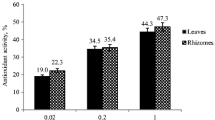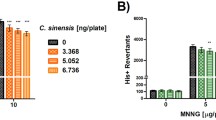Abstract
Naturally occurring plant phenolics,p-coumaric acid (PA), caffeic acid (CA), ferulic acid (FA) and gentisic acid (GA) (25–100 nmol/L) had protective effects on acridine orange (AO; 216 μmol/L)- and ofloxacin (3 μmol/L)-induced genotoxicity inSalmonella typhimurium. FA, GA and CA exhibited a significant concentration-dependent protective effect against the genotoxicity of AO and ofloxacin, with the exception of PA, which at all concentrations tested abolished the AO and ofloxacin genotoxicity. UV spectrophotometric measurements showed the interaction of PA, FA, GA and CA with AO but not with ofloxacin; this interaction is obviously responsible for the reduction of AO-inducedS. typhimurium mutagenicity. In the case of ofloxacin the antimutagenic effect of PA, FA, GA and CA is assumed to be a result of their ability to scavenge reactive oxygen species (ROS) produced by ofloxacin.
Similar content being viewed by others
References
Bagchi D., Hassoun E., Bagchi M., Stohs S.: Protective effects of antioxidants against Endrin-induced hepatic lipid peroxidation, DNA damage and excretion of urinary lipid metabolites.Free Radic. Biol. Med. 15, 217–222 (1993).
Belicová A., Krajčovič J., Dobias J., Ebringer L.: Antimutagenicity of milk fermented byEnterococcus faecium.Folia Microbiol. 44, 513–518 (1999).
Cuvelier M.L., Richard H., Berset C.: Comparison of the antioxidative activity of some-phenols: structure-activity relationship.Biosci. Biotechn. Biochem. 56, 324–325 (1992).
D'Aquino M., Buillion C., Chopra M., Devi D., Dunster C., James G., Niki E., Willson R.: Sulphydryl (thiol)-free radical formation, biochemically, by sonolysis, by radiolysis, and thermally: vitamin A, curcumin, muconic acid and related conjugated olefins as reference activity models.Methods Enzymol. 233, 34–36 (1994).
Ebringer L., Dobias J., Krajčovič J., Polónyi J., Križková L., Lahitová N.: Antimutagnes reduce ofloxacin-induced bleaching inEuglena gracilis.Mutat. Res. 359, 85–93 (1996).
Hermann M., Kapiotis S., Hofbauer R., Seelos C., Held I., Gemeiner B.: Salicylate promotes myeloperoxidase-initiated LDL oxidation: antagonization by its metabolite gentisic acid.Free Rad. Biol. Med. 26, 1253–1260 (1999).
Hooper D.C., Wolfson J.S.: Mechanisms of quinolone action and bacterial killing, pp. 53–75 in D. C. Hooper, J.S. Wolfson (Eds):Quinolone Antimicrobial Agents. American Society for Microbiology, Washington (DC) 1993.
Koshihara Y., Neichi T., Murota S., Lao A., Fujimoto Y., Tatsuno T.: Caffeic acid is a selective inhibitor for leucotriene biosynthesis.Biochim. Biophys. Acta 792, 92–97 (1984).
Križková L., Horniak L., Sláviková, S., Eberinger L.: Protective effect of sodium selenite on ofloxacin-induced loss of chloroplast DNA inEuglena gracilis.Folia Microbiol. 41, 329–332 (1996).
Križková L., Nagy M., Polónyi J., Ebringer L.: The effect of flavonoids on ofloxacin-induced mutagenicity inEuglena gracilis.Mutat. Res. 416, 85–92 (1998).
Križková L., Nagy M., Polónyi J., Dobias J., Belicová A., Grančai D., Krajčovič J.: Phenolic acids inhibit chloroplast mutagenesis inEuglena gracilis.Mutat. Res. 469, 107–114 (2000).
Laranjinha J., Almeida A., Madeira V.: Reactivity of dietary phenolic acids with peroxyl radicals: antioxidant activity upon low density lipoprotein peroxidation.Biochem. Pharmacol. 48, 487–494 (1994).
Laranjinha J., Viera O., Madeira V., Almeida L.: Two related phenolic antioxidants with opposite effects on vitamin E content in low density lipoproteins oxidized by ferrylmyoglobin: consumptionvs. regeneration.Arch. Biochem. Biophys. 323, 373–381 (1995).
Liu G.T., Zhang T.M., Wang B.E., Wang Y.W.: Protective action of seven natural phenolic compounds against peroxidative damage to biomembranes.Biochem. Pharmacol. 43, 147–152 (1992).
Macheix J., Fleuriet A., Billot J.:Fruit Phenolics, CRC Press, Boca Raton (USA) 1990.
Maron D.M., Ames B.N.: Revised methods for theSalmonella mutagenicity test.Mutat. Res. 113, 173–215 (1983).
Shahidi F., Wanasundara J.P.D.: Phenolic antioxidants.Crit. Rev. Food Sci. Nutr. 32, 67–103 (1992).
Suchý V., Nagy M., Tekedová D., Grančai D., Stará D.: Study of the constituents of the gee glue of the Slovak origin—VIII. Derivatives of dihydroflavone and caffeic acid.Farm. Obzor 62, 411–415 (1993).
Tanaka T., Kojima T., Kawamori T., Yoshimi N., Mori H.: Chemoprevention of diethylnitrosamine-induced hepatocarcinogenesis by a simple phenolic acid protocatechuic acid in rats.Cancer Res. 53, 2775–2779 (1993a).
Tanaka T., Kojima T., Kawamori T., Wang A., Suzui M., Okamoto K., Mori H.: Inhibition of 4-nitroquinoline-1-oxide-induced rat tongue carcinogenesis by the naturally occurring phenolic caffeic, ellagic, chlorogenic and ferulic acids.Carcinogenesis 14: 1321–1325 (1993b).
Terao J., Karasawa H., Arai H., Nagao A., Suzuki T., Takama K.: Peroxyl radical scavenging activity of caffeic acid and its related phenolic compounds in solution.Biosci. Biotech. Biochem. 57, 1204–1205 (1993).
Umezawa N., Arakane K., Ryu A., Mashiko S., Hirobe N., Nagano T.: Participation of reactive oxygen species in phototoxicity induced by quinolone antibacterial agents.Arch. Biochem. Biophys. 342, 275–281 (1997).
Vieira O., Escarqueil-Blanc I., Meilhac O., Basile J.P., Laranjinha J., Almeida L., Salvayre R., Negre-Salvayre A.: Effect of dietary phenolic compounds on apoptosis of human cultured endothelial cells induced by oxidized LDL.Brit. J. Pharmacol. 12, 565–573 (1998).
Zhou J., Ashoori F., Susuki S., Nishigaki I., Yagi K.: Protective effect of chlorogenic acid on lipid peroxidation induced in the liver of rats by carbon tetrachloride or60Co-irradiation.J. Clin. Biochem. Nutr. 15, 119–125 (1993).
Zhou Y.C., Zheng R.L.: Phenolic compounds and an analog as superoxide anion scavengers and antioxidants.Biochem. Pharmacol. 42, 1177–1179 (1991).
Author information
Authors and Affiliations
Corresponding author
Rights and permissions
About this article
Cite this article
Belicová, A., Križková, L., Nagy, M. et al. Phenolic acids reduce the genotoxicity of acridine orange and ofloxacin inSalmonella typhimurium . Folia Microbiol 46, 511–514 (2001). https://doi.org/10.1007/BF02817994
Received:
Issue Date:
DOI: https://doi.org/10.1007/BF02817994




